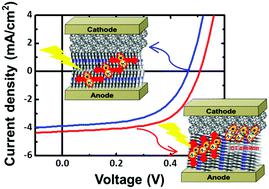当前位置:
X-MOL 学术
›
J. Mater. Chem. C
›
论文详情
Our official English website, www.x-mol.net, welcomes your feedback! (Note: you will need to create a separate account there.)
Influence of the metal phthalocyanine molecular orientation on charge separation at the organic donor/acceptor interface
Journal of Materials Chemistry C ( IF 6.4 ) Pub Date : 2021-1-4 , DOI: 10.1039/d0tc04895j Heeseon Lim 1, 2, 3, 4, 5 , Sena Yang 4, 5, 6 , Sang-Hoon Lee 3, 4, 7 , Jung-Yong Lee 3, 4, 7 , Yeunhee Lee 3, 4, 8, 9 , Andres Bethavan Situmorang 3, 4, 9, 10 , Yong-Hyun Kim 3, 4, 8, 9, 10 , Jeong Won Kim 4, 5, 6
Journal of Materials Chemistry C ( IF 6.4 ) Pub Date : 2021-1-4 , DOI: 10.1039/d0tc04895j Heeseon Lim 1, 2, 3, 4, 5 , Sena Yang 4, 5, 6 , Sang-Hoon Lee 3, 4, 7 , Jung-Yong Lee 3, 4, 7 , Yeunhee Lee 3, 4, 8, 9 , Andres Bethavan Situmorang 3, 4, 9, 10 , Yong-Hyun Kim 3, 4, 8, 9, 10 , Jeong Won Kim 4, 5, 6
Affiliation

|
To achieve highly efficient organic photovoltaics (OPVs), control of the molecular orientation is one of the prime important factors, for the interfacial dipole orientation and energy offset at the donor/acceptor (D/A) interface influence the device performance. We examine the effect of the planar-shape molecular orientation on the D/A interface, by comparing two different metal phthalocyanine molecules under identical process conditions. From the noticeable changes in the near edge X-ray absorption fine structure and ionization potential, copper phthalocyanine (CuPc) on a thin CuI layer reveals a strong change in molecular orientation compared to zinc phthalocyanine (ZnPc). To account for the different templating effect between CuPc and ZnPc, Cu d–d orbital coupling is evidenced as for the interaction between CuI and CuPc. The apparent change of the CuPc orientation reveals a relatively large energy offset at the CuPc/C60 D/A interface and increased open-circuit voltage in the corresponding OPV device. The lying-down orientation of CuPc on CuI or face-on geometry at the C60/CuPc interface induces strong electron–electron coupling and long-lived charge transfer exciton states, which is directly related to better charge separation and correspondingly good OPV performance.
中文翻译:

金属酞菁分子取向对有机供体/受体界面电荷分离的影响
为了实现高效的有机光伏(OPV),控制分子取向是主要的重要因素之一,因为界面偶极子取向和施主/受主(D / A)界面处的能量偏移会影响器件性能。通过在相同的工艺条件下比较两种不同的金属酞菁分子,我们研究了平面形分子取向对D / A界面的影响。从近边缘X射线吸收精细结构和电离电势的显着变化来看,薄的CuI层上的铜酞菁(CuPc)与锌酞菁(ZnPc)相比在分子取向方面显示出很大的变化。为了说明CuPc和ZnPc之间的不同模板效应,Cud-d轨道耦合被证明是CuI和CuPc之间的相互作用。60 D / A接口和相应的OPV器件中增加的开路电压。CuPc在CuI上的躺卧取向或C 60 / CuPc界面处的正面几何形状会引起强烈的电子-电子耦合和长寿命的电荷转移激子态,这直接关系到更好的电荷分离和相应的OPV性能。
更新日期:2021-01-20
中文翻译:

金属酞菁分子取向对有机供体/受体界面电荷分离的影响
为了实现高效的有机光伏(OPV),控制分子取向是主要的重要因素之一,因为界面偶极子取向和施主/受主(D / A)界面处的能量偏移会影响器件性能。通过在相同的工艺条件下比较两种不同的金属酞菁分子,我们研究了平面形分子取向对D / A界面的影响。从近边缘X射线吸收精细结构和电离电势的显着变化来看,薄的CuI层上的铜酞菁(CuPc)与锌酞菁(ZnPc)相比在分子取向方面显示出很大的变化。为了说明CuPc和ZnPc之间的不同模板效应,Cud-d轨道耦合被证明是CuI和CuPc之间的相互作用。60 D / A接口和相应的OPV器件中增加的开路电压。CuPc在CuI上的躺卧取向或C 60 / CuPc界面处的正面几何形状会引起强烈的电子-电子耦合和长寿命的电荷转移激子态,这直接关系到更好的电荷分离和相应的OPV性能。



























 京公网安备 11010802027423号
京公网安备 11010802027423号